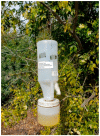The Potential of Fluralaner as a Bait Toxicant to Control Pest Yellowjackets in California
- PMID: 37103126
- PMCID: PMC10143787
- DOI: 10.3390/insects14040311
The Potential of Fluralaner as a Bait Toxicant to Control Pest Yellowjackets in California
Abstract
The western yellowjacket, Vespula pensylvanica (Saussure), is an important seasonal pest of recreational and outdoor venues in the western United States. Its propensity to scavenge food increases the likelihood of stinging incidences. Control measures are limited to intensive trapping and treating subterranean nests. The only toxicant registered for baiting in the US is esfenvalerate, which is ineffective. The objective of this study was to determine the potential of the isoxazoline fluralaner as a bait toxicant. With microsatellite genotyping, a minimum of 27 different colonies were shown to forage at a single monitoring site. Some colonies disappeared after baiting, and new colonies were detected. The implications for baiting and monitoring are discussed. Minced chicken and hydrogel baits containing 0.022% and 0.045% fluralaner significantly reduced foraging yellowjackets. Several bait applications covering large areas will be necessary to provide long-term control.
Keywords: Vespula pensylvanica; fluralaner; hydrogel baits; isoxazoline.
Conflict of interest statement
The authors declare no conflict of interest.
Figures






References
-
- Akre R.D., MacDonald J.F. Biology, economic importance and control of yellow jackets. In: Vinson S.B., editor. Economic Impact and Control of Social Insects. Praeger; New York, NY, USA: 1986. pp. 353–412.
-
- Rust M.K., Reierson D.A., Vetter R.S. Developing Baits for the Control of Yellowjackets in California. Final Report 2010 for Structural Pest Control Board Structural Pest Control Board, Grant No. 041–04. [(accessed on 5 March 2023)];2010 :1–33. Available online: http://www.pestboard.ca.gov/howdoi/research/2009_yellowjacket.pdf.
-
- Akre R.D. Economics and control of yellowjackets (Vespula, Dolichovespula) In: Breed M.D., Michener C.D., Evans H.E., editors. The Biology of Social Insects. Westview Press; Boulder, CO, USA: 1982. pp. 109–113.
-
- Ebeling W. Urban Entomology. Division of Agricultural Sciences, University of California; Berkeley, CA, USA: 1975.

